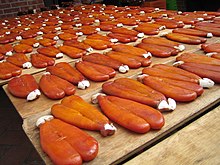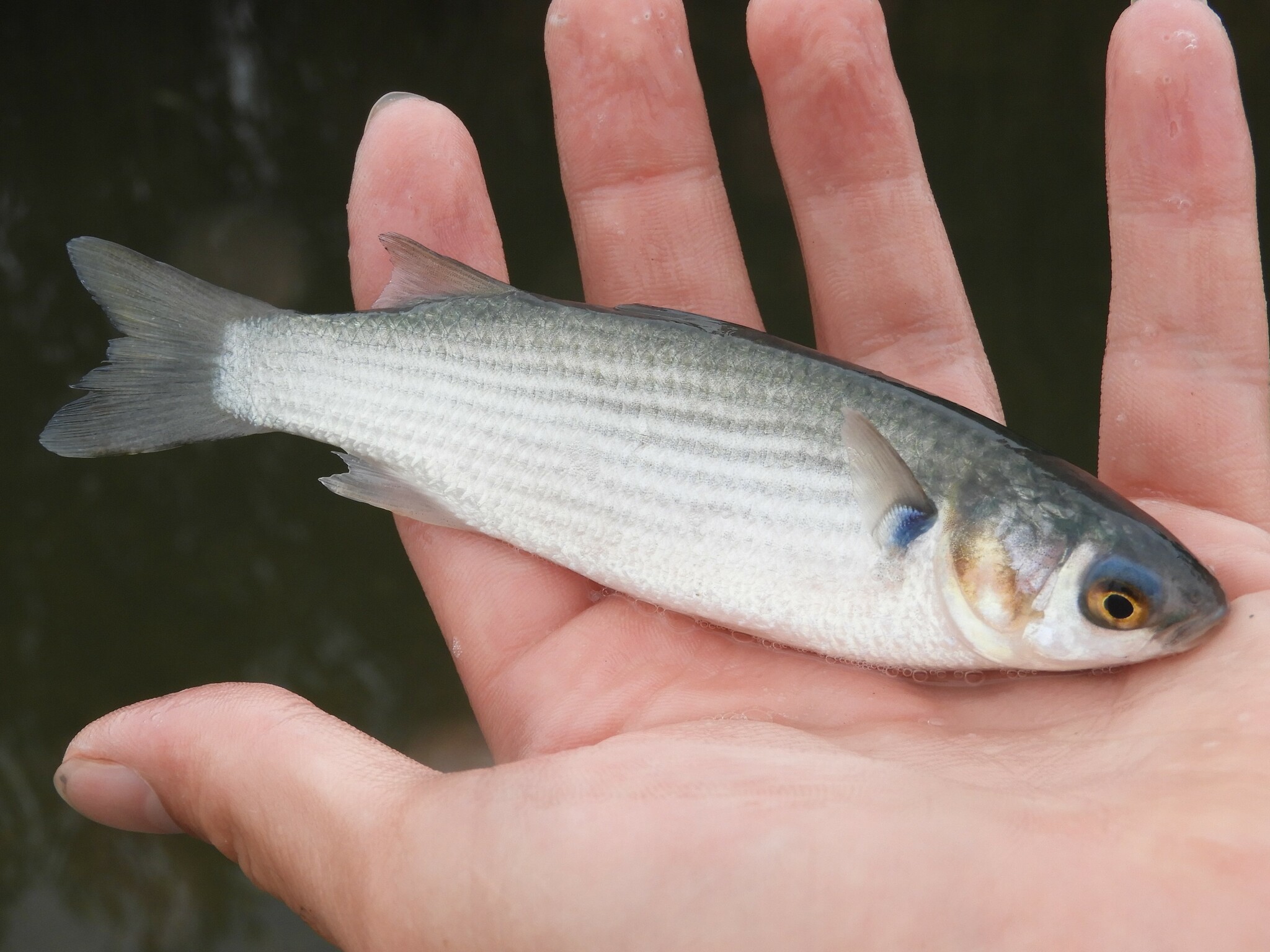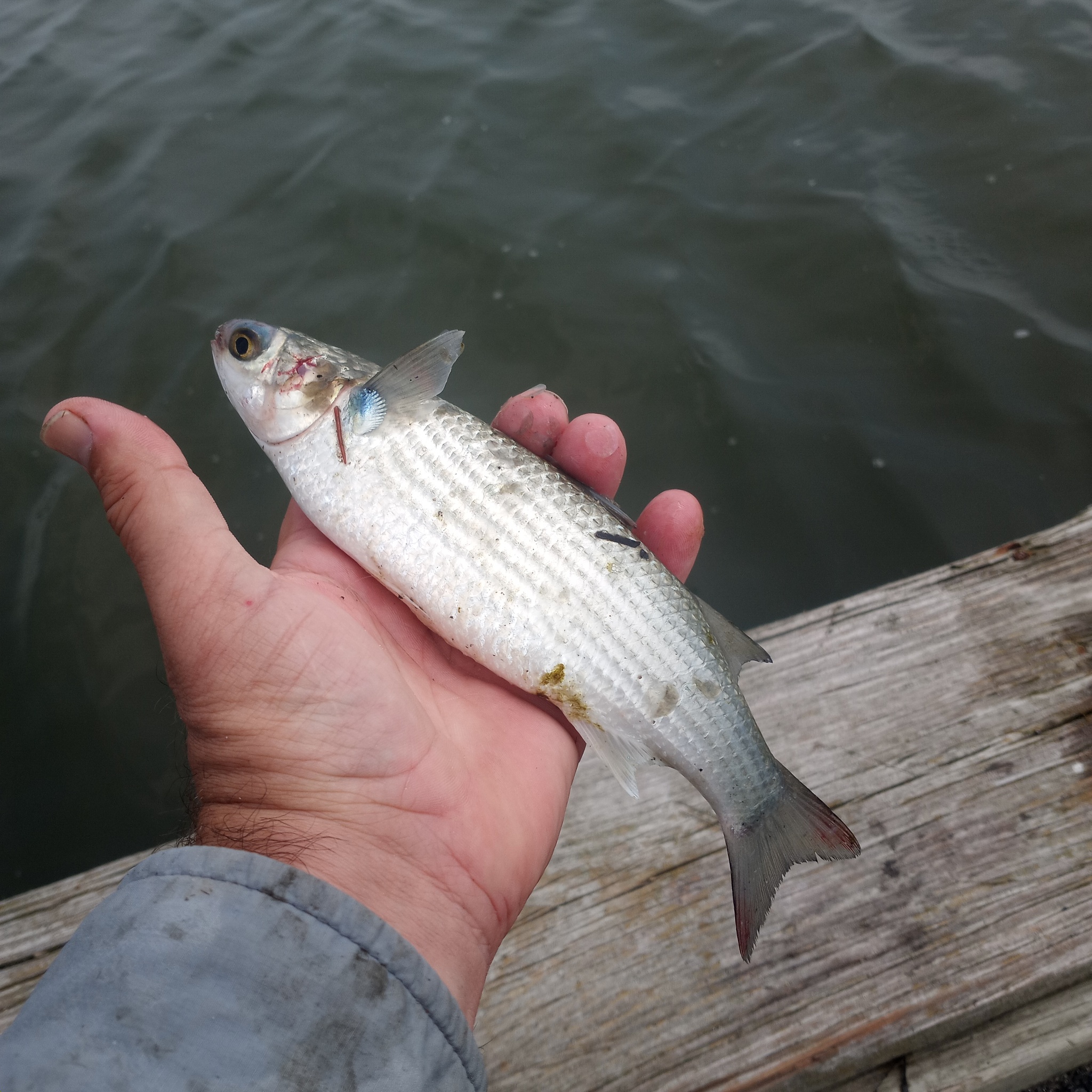Map Snapshot





23 Records
Seasonality Snapshot
Source: Wikipedia
| Flathead grey mullet | |
|---|---|

| |
| Scientific classification | |
| Domain: | Eukaryota |
| Kingdom: | Animalia |
| Phylum: | Chordata |
| Class: | Actinopterygii |
| Order: | Mugiliformes |
| Family: | Mugilidae |
| Genus: | Mugil |
| Species: | M. cephalus
|
| Binomial name | |
| Mugil cephalus | |
| Synonyms | |
| |
The flathead grey mullet[2] (Mugil cephalus) is an important food fish species in the mullet family Mugilidae. It is found in coastal temperate, tropical and subtropical waters worldwide.[2] Its length is typically 30 to 75 centimetres (12 to 30 in). It is known with numerous English names, including the flathead mullet, striped mullet (US, American Fisheries Society name), black mullet, bully mullet, common mullet, grey mullet, sea mullet and mullet, among others.[1][3]
The flathead grey mullet is a mainly diurnal coastal species that often enters estuaries and rivers. It usually schools over sand or mud bottoms, feeding on zooplankton, dead plant matter, microalgae and detritus.[4] The adult fish normally feed on algae in fresh water. The species is euryhaline, meaning that the fish can acclimate to different levels of salinity.[5]
Description
[edit]The back of the fish is olive-green, sides are silvery and shade to white towards the belly.[2] The fish may have six to seven distinctive lateral horizontal stripes. Lips are thin.[2] The mullet has no lateral line. A common length is about 50 centimetres (20 in), and its maximum length is 100 centimetres (39 in).[2] It can reach a maximum weight of eight kilograms (18 lb).[5]

Distribution
[edit]The flathead mullet is cosmopolitan in coastal waters of the tropical, subtropical and temperate zones of all seas,[2] as far north as the Bay of Biscay and Nova Scotia in the Atlantic Ocean.[1] It occupies fresh, brackish and marine habitats in depths ranging between 0–120 metres (0–394 ft) and with temperatures between 8–24 °C (46–75 °F).[5]
In Australia, the fish is widespread, from Far North Queensland, around southern Australia to the Kimberley region of Western Australia. They also occur in the Bass Strait area of Tasmania. They live in tropical and temperate coastal marine and estuarine waters, but are also often found in the lower reaches of rivers. They are able to live in a wide range of salinity and so may also be found in lagoons, lakes and far into estuaries, but migrate back to the sea to spawn.[6]
In freshwaters of the western United States, the striped mullet historically ranged far up the Colorado River to the vicinity of Blythe and up the Gila River to perhaps Tacna. Because of the dams and restricted flows to the Gulf of California, the range in Arizona is restricted to the Colorado River below Laguna Dam and the lower end of the Gila River when there is water present. They are often abundant in the mainstream and lateral canals in the Gila River region.[7]
In the Colorado River mullet are pelagic in larger pools, sometimes moving into currents below dams, and generally occurring in small groups.[5]
The mullet populations are currently declining in Arizona, due to periods when the Colorado River does not reach the Gulf of California.[citation needed]
Fisheries and aquaculture
[edit]The flathead grey mullet is an important food fish around the world, and it is both fished and farmed. The reported worldwide catches from fishing in 2012 were about 130,000 tonnes and aquaculture production was 142,000 tonnes.[8]
Development
[edit]The ontogeny of mugilid larvae has been well studied, with the larval development of Mugil cephalus in particular being studied intensively due to its wide range of distribution and interest to aquaculture.[9] The previously understudied osteological development of Mugil cephalus was investigated in a 2021 study, with four embryonic and six larval developmental steps being described in aquaculture-reared and wild-caught specimens.[9] These descriptions provided clarification of questionable characters of adult mullets and revealed informative details with potential implications for phylogenetic hypotheses, as well as providing an overdue basis of comparison for aquaculture-reared mullets to enable recognition of malformations.[9]
Cuisine
[edit]
The roe of this mullet is salted, dried, and compressed to make a specialty food across the world, such as Greek avgotaraho, Taiwanese Wuyutsu, Korean eoran, Japanese karasumi, Italian bottarga, French poutargue, Turkish Haviar and Egyptian batarekh. In Egypt, the fish itself is salted, dried, and pickled to make fesikh.[citation needed]
On the coast of Northwest Florida and Alabama, this mullet, called the striped or black mullet, is often a specialty of seafood restaurants. Fried mullet is most popular, but smoked, baked, and canned mullet are also eaten. Local fishermen usually catch mullet in a castnet, though most use a land-based seine net. Mullet is a delicacy in this area and is most often consumed in the home. Mullet are usually filleted, and the remaining frames used for fish stock in chowders and stews.[10] The mullet most commonly consumed in Florida however is the white mullet (Mugil curema), because its preference for cleaner water gives it a cleaner and less muddy taste.[11]
References
[edit]- ^ a b c Camara, K.; Carpenter, K.E.; Djiman, R.; et al. (2017). "Mugil cephalus". The IUCN Red List of Threatened Species. 2017: e.T135567A20682868. doi:10.2305/IUCN.UK.2017-3.RLTS.T135567A20682868.en.
- ^ a b c d e f Froese, Rainer; Pauly, Daniel, eds. (2014). "Mugil cephalus". FishBase.
- ^ Common names of Mugil cephalus FishBase (2014)
- ^ "Mugil cephalus (Black mullet)". Animal Diversity Web.
- ^ a b c d Minckley, W.L. 1973. Fishes of Arizona. Arizona Game and Fish Department, Phoenix. pp. 257–258.
- ^ Gomon, M.F.; Bray, D.J. (2019). "Mugil cephalus". Fishes of Australia. Retrieved 22 March 2020.
Resources: Australian Faunal Directory
- ^ Animal abstract: Mugil cephalus Archived 2016-12-31 at the Wayback Machine ARIZONA GAME AND FISH DEPARTMENT
- ^ "FAO Fisheries & Aquaculture - Species Fact Sheets - Mugil cephalus (Linnaeus, 1758)". fao.org. Archived from the original on 2015-11-05. Retrieved 2016-04-30.
- ^ a b c Thieme, Philipp; Vallainc, Dario; Moritz, Timo (2021). "Postcranial skeletal development of Mugil cephalus (Teleostei: Mugiliformes): morphological and life-history implications for Mugiliformes". Zoological Journal of the Linnean Society. 192 (4): 1071–1089. doi:10.1093/zoolinnean/zlaa123.
- ^ "Instituto Veneto di scienze, lettere ed arti environmental database on the pool of Venice". Archived from the original on 2010-10-13. Retrieved 2007-05-23.
- ^ McKee, David (2008). Fishes of the Laguna Madre. College Station, Tx: Texas A&M University Press. p. 196. ISBN 978-1-60344-028-8.
External links
[edit]- Photos of Flathead grey mullet on Sealife Collection








